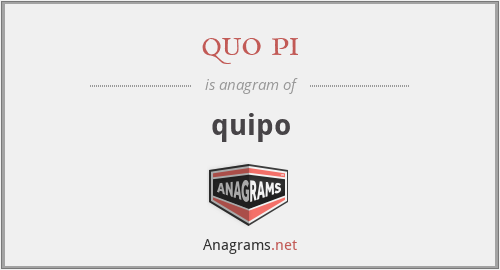What anagrams are available for quipo?
This page is about an anagram for the word quo pi that can be used in word games, puzzles, trivia and other crossword based board games.
quo pi
Translation
Find a translation for quo pi in other languages:
Select another language:
- - Select -
- 简体中文 (Chinese - Simplified)
- 繁體中文 (Chinese - Traditional)
- Español (Spanish)
- Esperanto (Esperanto)
- 日本語 (Japanese)
- Português (Portuguese)
- Deutsch (German)
- العربية (Arabic)
- Français (French)
- Русский (Russian)
- ಕನ್ನಡ (Kannada)
- 한국어 (Korean)
- עברית (Hebrew)
- Gaeilge (Irish)
- Українська (Ukrainian)
- اردو (Urdu)
- Magyar (Hungarian)
- मानक हिन्दी (Hindi)
- Indonesia (Indonesian)
- Italiano (Italian)
- தமிழ் (Tamil)
- Türkçe (Turkish)
- తెలుగు (Telugu)
- ภาษาไทย (Thai)
- Tiếng Việt (Vietnamese)
- Čeština (Czech)
- Polski (Polish)
- Bahasa Indonesia (Indonesian)
- Românește (Romanian)
- Nederlands (Dutch)
- Ελληνικά (Greek)
- Latinum (Latin)
- Svenska (Swedish)
- Dansk (Danish)
- Suomi (Finnish)
- فارسی (Persian)
- ייִדיש (Yiddish)
- հայերեն (Armenian)
- Norsk (Norwegian)
- English (English)
Definition
What does quipo mean?
- quipo
- Quipu (also spelled khipu) are recording devices fashioned from strings historically used by a number of cultures in the region of Andean South America.A quipu usually consisted of cotton or camelid fiber strings. The Inca people used them for collecting data and keeping records, monitoring tax obligations, collecting census records, calendrical information, and for military organization. The cords stored numeric and other values encoded as knots, often in a base ten positional system. A quipu could have only a few or thousands of cords. The configuration of the quipus has been "compared to string mops." Archaeological evidence has also shown the use of finely carved wood as a supplemental, and perhaps sturdier, base to which the color-coded cords would be attached. A relatively small number have survived. Objects that can be identified unambiguously as quipus first appear in the archaeological record in the first millennium AD (though debated quipus are much earlier). They subsequently played a key part in the administration of the Kingdom of Cusco and later the Inca Empire, flourishing across the Andes from c. 1100 to 1532 AD. Some have argued that as the region was subsumed under the Spanish Empire, the quipus were actively destroyed, to be replaced by European writing and numeral systems; but the Spanish response to the quipu is much more complicated than this. While certainly some quipu were identified as idolatrous and destroyed, the Spaniards actually promoted the adaptation of the quipu recording system to the needs of the colonial administration; and priests advocated the use of quipus for ecclesiastical purposes. In several modern villages, quipus have continued to be important items for the local community. It is unclear as to where and how many intact quipus still exist, as many have been stored away in mausoleums.Knotted strings unrelated to quipu have been used to record information by the ancient Chinese, Tibetans and Japanese.Quipu is the Spanish spelling and the most common spelling in English. Khipu (pronounced [ˈkʰɪpʊ], plural: khipukuna) is the word for "knot" in Cusco Quechua. In most Quechua varieties, the term is kipu.
Embed
Citation
Use the citation below to add this anagram to your bibliography:
Style:MLAChicagoAPA
"quo pi." Anagrams.net. STANDS4 LLC, 2024. Web. 30 Apr. 2024. <https://www.anagrams.net/term/11857457>.



Discuss this quipo anagram with the community:
Report Comment
We're doing our best to make sure our content is useful, accurate and safe.
If by any chance you spot an inappropriate comment while navigating through our website please use this form to let us know, and we'll take care of it shortly.
Attachment
You need to be logged in to favorite.
Log In